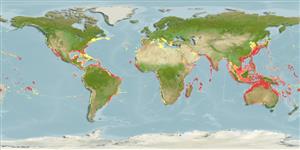>
Carangiformes (Jacks) >
Carangidae (Jacks and pompanos) > Caranginae
Etymology: Decapterus: Greek, deka = ten + Greek, pteron = wing, fin (Ref. 45335).
More on author: Cuvier.
Environment: milieu / climate zone / depth range / distribution range
ນິເວດວິທະຍາ
ສັດທະເລ; ລະດັບຄວາມເລິກ 0 - 400 m (Ref. 58302), usually 40 - 200 m (Ref. 3197). Subtropical; 54°N - 46°S, 180°W - 180°E
Circumglobal. Western Atlantic: Nova Scotia, Canada and Bermuda to approximately Rio de Janeiro, Brazil (Ref. 57756). Appears to be absent from the Gulf of Mexico (Ref. 9626). Eastern Atlantic: St. Helena, Ascension, Cape Verde, and Gulf of Guinea (Ref. 7097); Azores and Madeira (Ref. 4233). Indian Ocean: Red Sea, Gulf of Aden, Seychelles, Mascarenes, South Africa, and Sri Lanka (Ref. 3287). Eastern Pacific: Gulf of California and Revillagigedo Island to Ecuador (Ref. 9283).
ຂະໜາດ / ນ້ຳໜັກ / Age
Maturity: Lm ? range ? - ? cm
Max length : 46.0 cm TL ຕົວຜູ້/ບໍ່ມີເພດ; (Ref. 55763); common length : 30.0 cm TL ຕົວຜູ້/ບໍ່ມີເພດ; (Ref. 55763)
ຄີ (ໜາມ)ແຂງຢູ່ຫຼັງປາ (ທັງໝົດ) : 9; ຄີຫຼັງຂອງປາ (ຄີອ່ອນ) (ທັງໝົດ) : 31 - 37; ຄີ(ໜາມ) ແຂງຢູ່ຄີກົ້ນປາ
ກຸ່ມປາກະດູກແຂງ
ຄວາມຖີ່ຂອງກຸ່ມຖ່າຍທອດພັນ
ປາທີ່ມີການເຄື່ອນຍ້າຍຈາກທະເລໄປຫານ້ຳຈືດ ແລະນ້ຳຈືດຫາທະເລ
ປາທີ່ມີການເຄື່ອນຍ້າຍຈາກທະເລແລະໄປໄຂ່ຢູ່ນ້ຳຈືດ
ຄີກົ້ນຂອງປາ
ສັດທີ່ມີກະດູກສັນຫັຼງ
ການຖ່າຍທອດທາງກຳມະພັນຈາກພໍ່ແມ່ຫາລູກ: 3; ຄີກົ້ນຂອງປາ: 27 - 31; ສັດທີ່ມີກະດູກສັນຫຼັງ: 24. This species is distinguished by the following characters: oral valve (membrane) at symphysis of upper jaw conspicuously white in adults; posterior end of upper jaw straight above, moderately rounded and noticeably slanted anteroventrally; both jaws without teeth; shoulder girdle (cleithrum) margin with 2 small papillae, the lower papilla larger; terminal dorsal- and anal-fin rays each consisting of a widely detached finlet; pectoral fins short (58 to 72% of head length), tip of appressed fins falling considerably short of a vertical line from second dorsal-fin origin; lateral line scales, curved 58-75 and without scutes, straight 18-39 with 24-40 scutes, the total scales and scutes in lateral line (excluding scales on caudal fin) 110 to 138; interorbital scales usually extending to above front margin of the pupil. Colour in life bluish green and slivery below; small black blotch on margin of opercle near upper edge; caudal fin yellow-green and dorsal fin lobe sometimes dark distally; anal and pelvic fins pale to whitish (Ref. 9894, 11228).
Adults prefer clear oceanic waters, frequently around islands (Ref. 5217). Sometimes they are found near the surface, but generally caught between 40 and 200 m depth (Ref. 9283). Pelagic (Ref. 58302). Usually seen as fast moving schools along the reef edges near deep water (Ref. 48635, 26235). They feed mainly on zooplankton (Ref. 9283). Eggs are pelagic (Ref. 4233). Caught with purse seines and trawls (Ref. 9894). Marketed fresh and salted or dried (Ref. 9283).
Life cycle and mating behavior
ການຈະເລີນເຕັມໄວ | ການສືບພັນ | ການວາງໄຂ່ | ໄຂ່ | ຄວາມດົກຂອງໄຂ່ປາ | ຕົວອ່ອນ
Smith-Vaniz, W.F., 1995. Carangidae. Jureles, pámpanos, cojinúas, zapateros, cocineros, casabes, macarelas, chicharros, jorobados, medregales, pez pilota. p. 940-986. In W. Fischer, F. Krupp, W. Schneider, C. Sommer, K.E. Carpenter and V. Niem (eds.) Guia FAO para Identification de Especies para lo Fines de la Pesca. Pacifico Centro-Oriental. 3 Vols. FAO, Rome. (Ref. 9283)
IUCN Red List Status (Ref. 130435: Version 2024-1)
Threat to humans
Reports of ciguatera poisoning (Ref. 26235)
Human uses
ການປະມົງ: ເປັນສີນຄ້າ; ຊະນິດປາທີ່ຖືກນຳໃຊ້ເຂົ້າໃນການຫາເພື່ອເປັນເກມກິລາ: ແມ່ນ; ເຍື່ອ: usually
ເຄື່ອງມື
Special reports
Download XML
ແຫຼ່ງອີນເຕີເນັດ
Estimates based on models
Preferred temperature (Ref.
123201): 13 - 27.9, mean 21.9 °C (based on 2100 cells).
Phylogenetic diversity index (Ref.
82804): PD
50 = 0.5010 [Uniqueness, from 0.5 = low to 2.0 = high].
Bayesian length-weight: a=0.01202 (0.00782 - 0.01848), b=2.98 (2.85 - 3.11), in cm total length, based on LWR estimates for this species & Genus-body shape (Ref.
93245).
ຊັ້ນເຂດຮ້ອນ (Ref.
69278): 4.0 ±0.2 se; based on diet studies.
Generation time: 3.9 ( na - na) years. Estimated as median ln(3)/K based on 2
growth studies.
ຄວາມຢືດຢຸ່ນ (Ref.
120179): ສູງ, ປະຊາກອນຕຳ່ສຸດທີ່ໃຊ້ເວລາສອງໜ້ອຍກວ່າ 15 ເດືອນ (K=0.8).
Prior r = 1.08, 95% CL = 0.71 - 1.62, Based on 3 data-limited stock assessments.
Fishing Vulnerability (Ref.
59153): Low vulnerability (23 of 100).
Nutrients (Ref.
124155): Calcium = 472 [148, 1,769] mg/100g; Iron = 7.26 [2.38, 19.02] mg/100g; Protein = 21.3 [19.6, 23.0] %; Omega3 = 0.654 [0.270, 1.630] g/100g; Selenium = 84.1 [20.5, 289.9] μg/100g; VitaminA = 2.35 [0.40, 13.27] μg/100g; Zinc = 0.975 [0.518, 1.979] mg/100g (wet weight);
